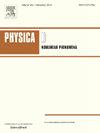Novel solitary patterns in a class of Klein–Gordon equations
IF 2.7
3区 数学
Q1 MATHEMATICS, APPLIED
引用次数: 0
Abstract
We study the emergence, stability and evolution of solitons and compactons in a class of Klein–Gordon equations endowed with both trivial and non-trivial stable equilibria, and demonstrate that similarly to the classical cases, solitons are linearly unstable, but the instability weakens as , and vanishes at , where solitons disappear and kink forms.
As the growing unstable soliton approaches the non-trivial equilibrium, it morphs into a ’mesaton’, a robust box shaped sharp pulse with a flat-top plateau, which expands at a sonic speed. In the vicinity, where instability is suppressed, whereas the internal modes have hardly changed, solitons persist for a very long time but then, rather than turn into mesaton, convert into a breather-like formation.
Linear damping tempers the conversion and slows mesaton’s propagation. When , compactons emerge and being unstable morph either into a mesaton or into a breather-like formation.
一类Klein-Gordon方程中的新孤立模式
本文研究了一类具有平凡和非平凡稳定平衡的Klein-Gordon方程utt - uxx+u=u1+n - κ1+2nu1+2n, - 1/2<;n中的孤子和紧子的出现、稳定性和演化,并证明了与经典的κ1+2n=0情况类似,孤子是线性不稳定的,但不稳定性随着κ1+2n ^而减弱,并在κ1+2ncrit=1+n(2+n)2时消失,孤子消失并形成结。当不断增长的不稳定孤子接近非平凡的平衡时,它就会变成一个“介子”,一个具有平顶平台的坚固的箱形尖锐脉冲,以音速膨胀。在κ1+2 crit附近,不稳定性被抑制,而内部模式几乎没有改变,孤子持续很长时间,但随后,而不是变成介子,转化为呼吸状的形成。线性阻尼缓和了转换并减缓了介子的传播。当- 1/2<;n<;0时,紧子出现,不稳定的紧子要么变成介子,要么变成类似呼吸的结构。
本文章由计算机程序翻译,如有差异,请以英文原文为准。
求助全文
约1分钟内获得全文
求助全文
来源期刊

Physica D: Nonlinear Phenomena
物理-物理:数学物理
CiteScore
7.30
自引率
7.50%
发文量
213
审稿时长
65 days
期刊介绍:
Physica D (Nonlinear Phenomena) publishes research and review articles reporting on experimental and theoretical works, techniques and ideas that advance the understanding of nonlinear phenomena. Topics encompass wave motion in physical, chemical and biological systems; physical or biological phenomena governed by nonlinear field equations, including hydrodynamics and turbulence; pattern formation and cooperative phenomena; instability, bifurcations, chaos, and space-time disorder; integrable/Hamiltonian systems; asymptotic analysis and, more generally, mathematical methods for nonlinear systems.
 求助内容:
求助内容: 应助结果提醒方式:
应助结果提醒方式:


